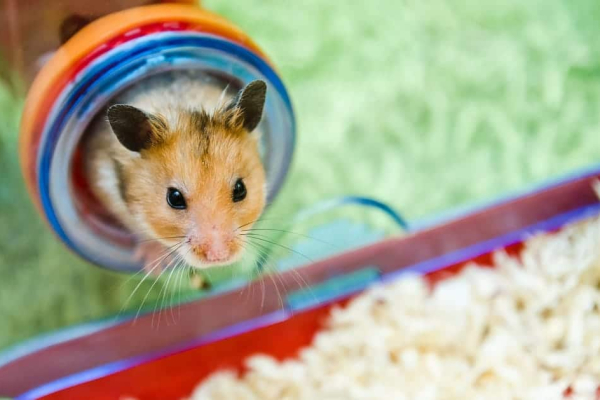
Hamsters show a lot of different odd behaviors from time to time and because of that, it can look strange to us when they do it.
One of those behaviors that can see odd is when a hamster goes into torpor, so what is torpor in hamsters?
When a hamster is in torpor what they’re doing is going into temporary hibernation for a while because it’s too cold for them. They’ll usually be in this state until they’re able to raise their body temperature or the temperature around them starts to warm up a little.
Sometimes it can be hard to tell when they’re actually in torpor but this is something normal that they do and it can last for a while.
What Is Torpor In Hamsters?
Torpor can look strange when it comes to hamsters especially when you’ve never seen it before, so what is it?
Torpor means temporary hibernation and hamsters can go into it when the environment that they’re in drops below a certain temperature.
It usually happens when the temperature around the hamster drops below 59 degrees Fahrenheit or 15 degrees Celsius.
So if you have your hamster’s cage in a colder part of the house, near an open window in the wintertime, or it’s just really cold in general for a good amount of time then they can go into it.
What it basically is is one of a hamster’s natural reactions to colder temperatures that they’re currently living in.
They’re trying to raise their body temperature to accommodate for the fact that it’s so cold.
When they’re doing this they’re also trying to conserve some of their energy by slowing down their metabolism as well.
So if a hamster feels extremely cold then they’ll go into torpor and it’s completely normal for them to do that.
How Can You Tell If A Hamster Is In Torpor?
When a hamster goes into torpor they will mainly be unresponsive but they will still be slowly breathing.
You can also tell if a hamster is in torpor if they feel cold as they try to raise their body temperature as well.
Their breathing will be a lot slower than usual and sometimes it can even be hard to tell if they are actually breathing because they slow it down so much.
So because of that, you would have to closely look at their chest area to see if it’s moving up and down.
Also, another way to tell if a hamster is in torpor is if their little whiskers still move every now and then as well.
The reason why their whiskers still move a little bit is that their body is still slightly active, so even though it can be hard to see it’s still happening and it’s something to look out for.
Sometimes it can be difficult to tell if a hamster is dead or if they’re in torpor because both can look similar to each other.
But one of the ways to tell if your hamster is actually dead and not in torpor is if rigor mortis is starting to set in.
When rigor mortis sets in their body will feel really stiff and their muscles and ligaments will lock up which is very different from when they’re in torpor.
So if you’re feeling unsure if your hamster is dead or in torpor what you can do is try to gently move their body around.
If you move one part of their body and their whole body is stiff and goes with it, then rigor mortis has most likely set in and they may have died.
But if you move a part of their body and it moves in an almost natural way without the rest of their body going with it, then they’re probably just in torpor.
How Long Does Torpor Last For Hamsters?
When hamsters go into this type of state it can last for various lengths of time, but how long does torpor last for hamsters and when will they come out of it?
How long torpor lasts for hamsters is usually dependent on how cold it is and how long it’s been cold around them.
Most of the time it can last about a few hours but it can also go on for a few days as well.
So if the environment that they’re in is consistently cold then they’ll stay in torpor until they can warm themselves up.
Once the temperature around them rises again they’ll slowly start to come out of torpor as they become warmer.
But once a hamster does come out of torpor their motor functions will still need some time to catch up to their body.
So you might see them stumble around a little bit because they may still feel a little disoriented, and that’s okay because they’ll soon return to normal.
Can You Bring A Hamster Out Of Torpor?
Hamsters go into torpor when it becomes too cold for them to handle, so they have to go into this state so that they can try to raise their body temperature.
So because torpor happens when the temperature sharply drops around a hamster, that means that there may be something that you can do to bring them out of it if you don’t feel comfortable with them being that way.
That being said, this can take a while to do, sometimes it can take up to three hours.
So you’ll have to have some patience with them when you’re trying to get them out of torpor.
One of the things that you can do to try to bring your hamster out of torpor is to place a small blanket on them so that their body heat has a hard time escaping.
What the blanket can do is trap their body heat which can speed up the process of them trying to warm themselves up.
Another thing that you can try to do to help bring your hamster out of torpor is to move them to a warmer room than the one that they’re currently in.
But if you are unable to move them to a warmer room then you can just make sure that any of the windows that can bring in cold air are shut.
You can also make sure that their cage is not near a vent blowing cold air at it as well.
Once your hamster is out of torpor just make sure to keep the temperature around them above 59 degrees Fahrenheit or 15 degrees Celsius.
Also, just to be safe consult a veterinarian or go see your local one if you think that something is wrong with your hamster or if they don’t come out of torpor for an extended period of time.












